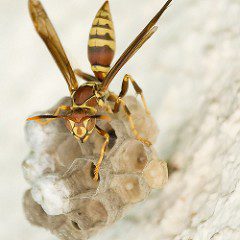 This year has been a fascinating case study about how seasons truly affect the behavior of pests. This year spring stuck around with us right until the Summer Solstice. Likewise, pests’ levels stayed spring-like until very recently. In the past two weeks, we’ve seen a significant explosion of elm seed bugs, wasps, spiders, and other pests…Incredible.
This year has been a fascinating case study about how seasons truly affect the behavior of pests. This year spring stuck around with us right until the Summer Solstice. Likewise, pests’ levels stayed spring-like until very recently. In the past two weeks, we’ve seen a significant explosion of elm seed bugs, wasps, spiders, and other pests…Incredible.
With the explosion of pest populations, we’ve observed an incredible number of varieties of pests we’ve seen. This has been especially true among the different stinging insects we’ve seen throughout the past few weeks. Whenever I hear the word stinging insect, I think about things like bees and wasps. These are the most obvious answers to the question, “name as many stinging insects as you can.” But it is essential to know there is a greater variety than bees and wasps. For example, are you aware that several ants are classified as stinging insects? Ants such as Harvester and Velvet are examples of stinging ants.
Besides often overlooked insects, the basic answers of bees and wasps represent broad terms for diverse groups. In the past three weeks, I have been shown, either with a picture or physical specimen, three species of wasps that are not paper wasps. It is important to know that although we often remember stinging insects for their titular stings, the vast majority do not sting humans. Among those that might, most only do so when seriously threatened. Only certain varieties of yellow jackets, hornets, and Africanized Honey Bees are aggressive.
So what’s important here? First, take comfort in that most stinging insects don’t do what their name entails. And second, make sure to know what type of pest you are dealing with before proceeding. If you are a current customer, our technicians can help make that determination at your regularly scheduled Quarterly Pest Control service. If you aren’t a customer, call today, and we can set up a free sales visit so the technician can give you all the treatment options available to help solve your problems.
